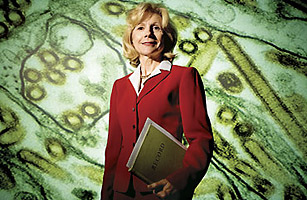
In her lab at the Centers for Disease Control in Atlanta, virologist Nancy Cox is engineering a nightmare public-health scenario: growing the bird-flu virus together with a highly contagious human influenza strain. No, she's not crazy. She figures a merger of those two microbes — which could happen in any person anywhere in the world and trigger a deadly pandemic — is too important to leave to chance. So she's putting the microbes together in a controlled way, under strict safety conditions, to see whether all the hand wringing is justified. "The goal is to see if these gene combinations are actually viable or not," she says.
There may be no better person to oversee the study than Cox, 57. A soft-spoken native of Iowa who chooses her words carefully because they carry such weight in the medical community, Cox is analyzing blood samples from patients around the world infected with bird flu, looking for clues that would help her design a vaccine. "When you work with an organism like influenza that's ever changing, you learn something new every year, so it never gets dull," she says. Already she has learned enough to suspect that one vaccine won't be enough; Cox believes we'll likely need at least two different vaccines tailor-made against specific viral strains. So far, the virus is winning; it mutates too quickly to be pinned down. But if anyone can do it, it's Cox.